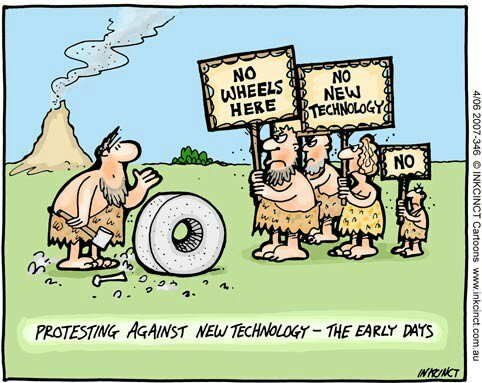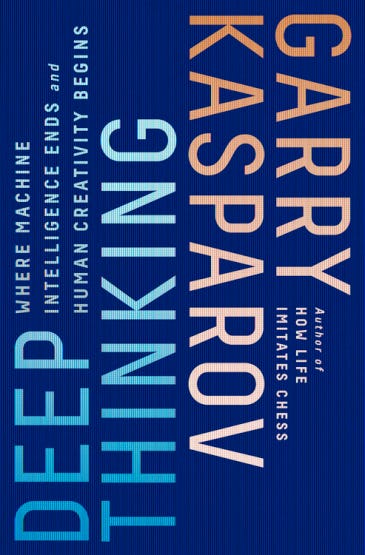[originally posted on Medium]
Today is the anniversary of the day the machines took over.
Exactly twenty years ago today, on May 11, 1997, the great chess grandmaster Garry Kasparov became the first chess world champion to lose a match to a supercomputer. His battle with IBM’s “Deep Blue” was a highly-publicized media spectacle, and when he lost Game 6 of his match against the machine, it shocked the world.
At the time, Kasparov was bitter about the loss and even expressed suspicions about how Deep Blue’s team of human programmers and chess consultants might have tipped the match in favor of machine over man. Although he still wonders about how things went down behind the scenes during the match, Kasparov is no longer as sore as he once was about losing to Deep Blue. Instead, Kasparov has built on his experience that fateful week in 1997 and learned how he and others can benefit from it.
The result of this evolution in his thinking is Deep Thinking: Where Machine Intelligence Ends and Human Creativity Begins, a book which serves as a paean to human resiliency and our collective ability as a species to adapt in the face of technological disruption, no matter how turbulent.
Kasparov’s book serves as the perfect antidote to the prevailing gloom-and-doom narrative in modern writing about artificial intelligence (AI) and smart machines. His message is one of hope and rational optimism about future in which we won’t be racing against the machines but rather running alongside them and benefiting in the process.
Overcoming the Technopanic Mentality
There is certainly no shortage of books and articles being written today about AI, robotics, and intelligent machines. The tone of most of these tracts is extraordinarily pessimistic. Each page is usually dripping with dystopian dread and decrying a future in which humanity is essentially doomed.
As I noted in a recent essay about “The Growing AI Technopanic,” after reading through most of these books and articles, one is left to believe that in the future: “Either nefarious-minded robots enslave us or kill us, or AI systems treacherously trick us, or at a minimum turn our brains to mush.” These pessimistic perspectives are clearly on display within the realm of fiction, where every sci-fi book, movie, or TV show depicts humanity as certain losers in the proverbial “race” against machines. But such lugubrious lamentations are equally prevalent within the pages of many non-fiction books, academic papers, editorials, and journalistic articles.
Given the predominantly panicky narrative surrounding the age of smart machines, Kasparov’s Deep Thinking serves as a welcome breath of fresh air. The aim of his book is finding ways of “doing a smarter job of humans and machines working together” to improve well-being.
Chess fans will enjoy Kasparov’s overview of the history of the game as well as his discussion of how the development of computing and smart machines has been intermingled with chess for many decades now. They will also appreciate his detailed postmortem of his losing battle with Deep Blue, which makes up the meat of the middle of the book. But what is important about the book is the way Kasparov draws out lessons about how the game of chess and chess players themselves have adapted to the rise of smart machines over time — just as he had to following his historic loss to Deep Blue.

Kasparov begins by noting that the growing panic over machine-learning and AI is unwarranted, but in another sense entirely unsurprising. He correctly observes that, “doomsaying has always been a popular pastime when it comes to new technology” and that, “With every new encroachment of machines, the voices of panic and doubt are heard, and they are only getting louder today.”
Fears of sectoral disruptions and job displacements are nothing new, of course, and many of them have even proven legitimate, Kasparov notes. He discusses “a pattern that has repeated over and over for centuries,” in which humans initially scoffed at the idea of machines being able to compete with them. “Eventually we have had to concede that there is no physical labor that couldn’t be replicated, or mechanically surpassed.” That includes the game of chess, where smart machines are now superior to the world’s best players.
But that doesn’t mean we can or should stop the progression of machine intelligence, he says, because the history of humanity is fundamentally tied up with the never-ending process of technological improvements and the gradual assimilation of new tools into our lives, jobs, and economy. He argues:
“Every profession will eventually feel this pressure, and it must, or else it will mean humanity has ceased to make progress. We can either see these changes as a robotic hand closing around our necks or one that can lift us up higher than we can reach on our own, as has always been the case. Romanticizing the loss of jobs to technology is little better than complaining that antibiotics put too many grave diggers out of work.”
That is why it is essential, Kasparov argues, that we not waste time trying to avoid these changes altogether. He regards the very idea of it as an exercise in futility. “Fighting to thwart the impact of machine intelligence is like lobbying against electricity or rockets,” he says. Instead, he argues, we must look to adapt, and do so quickly.
Adaptation, Resiliency & Risk-Taking
In that sense, Kasparov suggests that there are lessons for us in the history of chess as well as from his own experience competing against Deep Blue. He notes that his match against IBM’s supercomputer, “was symbolic of how we are in a strange competition both with and against our creation in more ways every day.”
Instead of just throwing our hands up in the air in frustration, we must be willing to embrace the new and unknown — especially AI and machine-learning. “Each of us has a choice to make: to embrace these new challenges, or to resist them.” His consistent plea throughout the book is to not give into to our worst fears, but instead to embrace these new technological challenges with a willingness to try new ways of doing things. “No matter how many people are worried about jobs, or the social structure, or killer machines, we can never go back,” he concludes.
On that point, my favorite passage in his book comes early in a short chapter about the history of chess. Kasparov’s sagacious advice is worth quoting at length:
“The willingness to keep trying new things — different methods, uncomfortable tasks — when you are already an expert at something is what separates good from great. Focusing on your strengths is required for peak performance, but improving your weaknesses has the potential for the greatest gains. This is true for athletes, executives, and entire companies. Leaving your comfort zone involves risk, however, and when you are already doing well the temptation to stick with the status quo can be overwhelming, leading to stagnation.”
Societal attitudes toward risk-taking and disruption matter profoundly in this regard because “our perspective on disruption affects how well prepared for it we will be” for the future. Again, the lessons from the world of chess are clear: “How professional chess changed when computers and databases arrived is a useful metaphor for how new technology is adopted across industries and societies in general.” For modern chess players, “it was a matter of adapting to survive,” he argues. “Those who quickly mastered the new methods thrived; the few who didn’t mostly dropped down the rating lists.”

Disrupting Education
Kasparov is particularly concerned about how a deep underlying conservatism and resistance to experimentation has become a chronic problem within the traditional educational system. “The prevailing attitude is that education is too important to take risks. My response is that education is too important not to take risks,” he says.
He again returns to the world of chess and he speaks with excitement about the ways in which young chess prodigies are tapping computers and sophisticated programs to supplement their skill-building. They do this, Kasparov says, even though they often receive little encouragement from the older guard, who often still resist the new methods of learning. “We need to find out what works and the only way to do that is to experiment,” he argues. “The kids can handle it. They are already doing it on their own. It’s the adults who are afraid.”
He’s also bullish on the globalization of these trends and the way in which “technology will enable people from all over the world to become entrepreneurs, or scientists, or anything they want despite where they live.” Kasparov believes this is already happening within the global chess community as new computing technologies help players everywhere raise the level of their skills. “Kids are capable of learning far more, far faster, than tradition educational methods allow for,” he argues. “They are already doing it mostly on their own, living and playing in a far more complex environment than the one their parents grew up in.”
Problems Ahead
Kasparov isn’t blind to the potential problems associated with new technologies, including AI and algorithmic systems. The potential for privacy violations represents one of the major concerns related to our powerful new technological capabilities. “There are countless privacy issues to be negotiated anytime [personal] data is accessed, of course, and that trade-off will continue to be one of the main battlefields of the AI revolution.”
Kasparov says he is “glad privacy advocates are on the job, especially regarding the powers of the government,” yet he also senses that we are our own worst enemies because new digital technologies and AI-enabled systems “will continue to make the benefits of sharing our data practically irresistible.” “Utility always wins,” he argues, and even if one country seeks to clamp down on innovation, others will welcome it. “When the results come back and show that the economic and health benefits are tremendous, the floodgates will open everywhere.”
He is probably right. After all, as I have noted in recent essays, we increasingly live in a world where “global innovation arbitrage” — i.e., the increasingly frictionless movement of innovations to jurisdictions that provide a legal and regulatory environment more hospitable to entrepreneurial activity — is increasingly easy. We already know how challenging it is to control data flows in the age of the Internet, smartphones, and social media. But the combination of more sophisticated forms of machine-learning and the rise of innovation arbitrage opportunities means that formidable challenges lie ahead in terms of digital privacy and cybersecurity.
Other ethical issues will need to be worked out over time, but it is important not to imbue new AI technologies or automated systems with too much moral weight right out of the gates. “Our technology is not concerned about good or evil. It is agnostic,” Kasparov correctly notes. The real question, he says, is how we ourselves put our tools to use. “The ethics are in how we humans use it, not whether we should build it.”

Humility about the Future
Despite some concerns such as these, Kasparov is generally quite bullish about the future of humanity in an age of smart machines. Again, his core message is that, “going backwards isn’t an option” and that “it is almost always better to start looking for alternatives and how to advance the change into something better instead of trying to fight it and hold on to the dying status quo.”
He agrees with many other pundits that new skills and jobs will be needed going forward, but admits they aren’t always easy to plan for in advance. As Yogi Berra once famously said, “It’s tough to make predictions, especially about the future.” Indeed, as I pointed out in the most recent edition of my book Permissionless Innovation, when one looks back at official government labor market studies and forecasts from the 1970s and 1980s, you are struck by the way in which policymakers didn’t even have a vocabulary to describe the jobs and skills of the present. For example, you find no mention in past reports of some of today’s hottest jobs, such as software engineers and architects, UX designers, database scientists and administrators, and so on.
On one hand, therefore, pessimistic pundits and policymakers regularly underestimate the adaptability of workers and the evolution of new skills and professions. On the other hand, they make an equally egregious mistake when they overestimate the impact of technological change on many sectors and professions, or suggest that mass unemployment is just around the corner unless we slow automation down.
Just this week, the Information Technology and Innovation Foundation released a new report on the impact of technological disruption in the U.S. labor market from 1850 to present and decried the “false alarmism” often on display in debates about current and future skills and professions. “Labor market disruption is not abnormally high,” conclude authors Robert D. Atkinson and John Wu, but instead, “it’s occurring at its lowest rate since the Civil War.”
We’ve been through more turbulent labor market disruptions in the past and weathered the storm. Chances are we will do so again, so long as we embrace the potential for that change to improve our lives and economy in the long-term. “In fact,” conclude Atkinson and Wu, “the single biggest economic challenge facing advanced economies today is not too much labor market churn, but too little, and thus too little productivity growth.” This is consistent with Kasparov’s repeated call in Deep Thinking for us not to give in to our fears about a highly uncertain future but to instead embrace its potential. “Our machines will continue to make us healthier and richer as we use them wisely,” he says, while adding, “They will also make us smarter.”
Learning by Doing
What Kasparov is really doing throughout the book is making the case for building human and institutional resiliency through a constant willingness to experiment and learn through trial and error. It is certainly true that many of today’s skillsets, professions, and business models will be challenged by the rise of smarter machines and algorithmic learning. Defeatism in the face of that prospect, however, isn’t the answer; adaptation is.
Boston University economist James Bessen wrote about this process in his new book, Learning by Doing. Bessen argued that periods of profound technological change require a willingness by workers, businesses, and other institutions to adjust to new marketplace realities. For progress to occur, large numbers of ordinary workers must acquire new knowledge and skills. However, “that is a slow and difficult process, and history suggests that it often requires social changes supported by accommodating institutions and culture,” Bessen notes.
Luckily, history also suggests that we have been through this process many times before and can get through it again — and raise the standard of living for workers and average citizens alike over the long-run. The crucial part of that process is a general willingness to continue to experiment with new ways of doing things — i.e., learning by doing — and understanding that new skills and professions will emerge from all that process.
That is essentially the same point Kasparov makes in Deep Thinking. As he summarized in a new podcast conversation with Tyler Cowen:
“There will be redistribution of jobs. Many jobs today — like drone operators or 3D printer managers or social media managers — they didn’t exist 10 years ago, 15 years ago. No doubt in 10, 15 years, there will be many jobs, maybe the best-paid jobs, that don’t exist today, and we don’t even know how these jobs will look. I think that’s natural. All we have to do is realize that this process is inevitable, and we have to prepare us mentally, but also to have some sort of safety cushions to help people that will have great difficulty in adjusting.”
What about more specific public policy solutions? Considering the unclear future that lies ahead, flexibility and plenty of policy experimentation will be crucial to finding and unlocking new methods that could help us cope and adapt in the new world. “The problem comes when the government is inhibiting innovation with overregulation and short-sighted policy,” Kasparov says. Trade wars and restrictive immigration policies won’t help matters either, he argues, because they “will limit America’s ability to attract the best and brightest minds.” Hopefully the Trump Administration is listening to his advice in this regard.
AI skeptics and other technology critics will lament Kasparov’s lack of greater detail and the absence of a more precise blueprint for helping workers and institutions navigate an uncertain future. But, again, the entire point of Kasparov’s book is that there is enormous value in the very act of confronting those new challenges, learning through trial-and-error(including the many accompanying failures), and “muddling through” over time.
Much like looking out over the chessboard and pondering the wisdom of our next move, we cannot be frozen into inaction because of fear. We must be willing to make that next move. And then another, and another. And then we must learn from our experiences, and especially our mistakes, if we hope to prosper. “To keep ahead of the machines, we must not try to slow them down because that slows us down as well,” Kasparov concludes in his closing chapter. “We must speed them up. We must give them, and ourselves, plenty of room to grow. We must go forward, outward, and upward.”
Wise advice from the greatest of all grandmasters.


 The Technology Liberation Front is the tech policy blog dedicated to keeping politicians' hands off the 'net and everything else related to technology.
The Technology Liberation Front is the tech policy blog dedicated to keeping politicians' hands off the 'net and everything else related to technology.